Table of contents
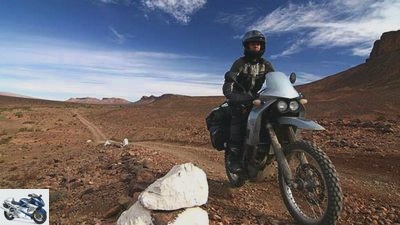
Kirchgebner
to travel
On the way: Morocco
On the way: Morocco
Between heaven & Earth
No country in North Africa offers such diversity. Mountains over 4000 meters high, cities like from 1001 nights and finally the outermost sand foothills of the Sahara.
11/06/2008
Actually everything is going fine. In Chefchaouen the first hundred kilometers of Morocco are behind us, and the wonderfully green, varied Rif mountains in the south of the Mediterranean coast begin. It couldn’t be better. Even the strenuous journey by car and trailer to Tarifa in southern Spain went smoothly. On the Atlantic in the morning we watched the kite surfers dancing with the wind and waves, after which customs and the short ferry passage across the Strait of Gibraltar were completed within an hour, and we were already on African soil in Tangier.
Actually everything is fine. But suddenly it’s back. The bad feeling, long believed to be forgotten, that is now boring into your stomach. The thoughts of the moment last year when we were already here and the trip suddenly took a completely unexpected turn. When the screw finally said goodbye to the machine was not understandable. The consequences on the way to Fès are all the more obvious when the freed chain sprocket detached itself from the drive shaft during an overtaking process and wedged itself intimately between the frame and the swing arm with the chain that followed happily. If the Trumm hadn’t also detached itself from the sprocket – safely braking the machine with the locking rear wheel at this speed would probably hardly have been possible. The journey was over before it really started.
As I drive by, I recognize the place where we sat on the side of the road and waited for help. I take another deep breath and try to leave this place behind me spatially and mentally with every meter as we roll through the southern foothills of the Rif Mountains. Every little piece of arable land is intensively cultivated here, and children wave to us. Farmers sit by the roadside with their harvest and wait for a transport to the next town. We take a break at an olive mill. Mourad, the owner, notices our interest and gives a crash course in oil production. It shows how a donkey keeps the seemingly archaic olive press in motion in a calm circle. Soon his children are running up and drawing us into cordial contact.
The sun has just passed its zenith, so there is enough time to go south for a few more hours. The landscape becomes more extensive and the course of the road can be seen as far as the horizon. Small towns offer variety with a lively hustle and bustle: oily workshops where repairs are carried out on open engines, street barbecues with mutton hung up as a menu, tire dealers between mountains of new and old tires.
Buy complete article
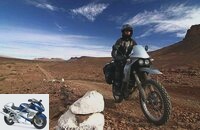
On the way: Morocco
Between heaven & Earth
12 pages) as PDF
€ 2.00
Buy now
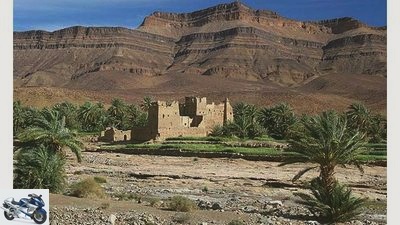
Kirchgebner / Osterle
Old Kasbahs: early protection of the Berbers against enemies and heat.
We let the singles run and screw our way south of Meknes up the first climbs of the Middle Atlas and towards the mountain resorts of Azrou and Ifrane. Poplars and chestnut trees form trellises along the road, behind which huge orchards spread out. We find a campsite under a roof made of cherry blossoms. In addition, a warm shower and silent Spanish table neighbors in the bar, whose vehicle has obviously had long-term contact with something big.
We underestimated the conditions in the Middle Atlas a little. An icy westerly wind blows on the barren high plateau towards Midelt, which makes the dress code rethink several times. The simplest dwellings of nomad families crouch down in search of protection on the wide area. With small stone walls, the residents try to wrest some living space from the rough landscape. A little later we reach the crater lake Aguelmame Sidi Ali, where nature, in the interplay of wind, water and lava rock, conjures up pastel colors in the finest gradations on the horizon. I’m driving close to the shore – too close. The soft ground engulfs the front wheel just as I take my foot off the accelerator. I fly through the air in a high arc, always expecting the packed machine behind me. But I am very lucky, only a muddy front remains a witness of my heroic deed. The second attempt almost came to an abrupt end just 100 kilometers further south than last year.
The wind has added a few more shovels and whistles ice cold around our ears. But the view is breathtaking. On the right the white Djebel Ayachi as a harbinger of the High Atlas, in the south the dark cloud front of an approaching storm. Like two opponents before the fight, they seem to be eyeing each other. Our path leads right through it. The wind has easy play with the high, fully packed machines, pushes them again and again deeply into an inclined position, does not let us come to rest. We finally pass Midelt, stopping in Errachidia just for a coffee. Blown up sand has now turned the sky orange-red. A hotel offers protection for the night. Tomorrow the spook will be over – inshallah, Allah willing.
The fever comes overnight, takes hold of me tightly. And leaden rain falls outside. For two days. Then the morning air is clear again and I feel able to keep the KTM reasonably on course. Because we are planning a detour to the nearby dunes. Go down from the hotel car park, turn right twice and then take the train straight ahead. Entering the desert is seldom as easy as on Erg Chebbi. Due to the past rains, the sand carries extremely well and gives the coarse tugs a lot of propulsion. Even the high dunes can be climbed with a little swing. But it has to be stopped precisely at the ridge. Too early is bad because it usually leads to sweaty pushing actions. Too late is fatal, as the steep drop that follows usually only works safely in a stable driving position at high speed. Apart from that, the ridge offers a wonderful view over the dune area and the adjoining desert oasis Merzouga.

Kirchgebner / Osterle
Sand hole: KTM in an unstable lateral position on the banks of the Aguelmame Sidi Ali.
The sandpit is slowly filling up. On two or four wheels, on foot or on hoof – it is nine thirty, the desert begins to live. I start the descent with a lot of noise and am already expected below. A small, barefoot boy with a shield cap means unmistakably to me that he wants to test drive the KTM. In the absence of safety equipment, it remains with a seat sample.
In the direction of Tazzarine, the tar ribbon meanders through the plain desert landscape to the west. Goat herds keep appearing on patrol through the sparse vegetation. Isolated nomad tents shine like white blobs on a light brown canvas. The entrance to the slope behind Tazzarine to the Tizi-n-Tafilalet pass is camouflaged by a noticeable inconspicuousness. Only an old Bedford pickup shows us the way. The low sun bathes the landscape in wonderful light. High rock walls constrict the valley more and more, palm trees line the small watercourse. Again and again we stop and enjoy the striking contrasts of the landscape. And so the Bedford, slowly but steadily rumbling along, decides the last few kilometers for itself. The oblique rays of the sun tickle your nose again. Time to find a place for the night. There seems to be no shortage of suitable storage sites. A shepherd dog is barking nearby. At this point in time, we have no idea that all of his offspring will yelp in front of our tent as a wake-up call the next morning.
The slope extends like a thin thread to the horizon. The bumps not too high, the stones not too big, ideal conditions to let the single cylinder off the leash. So we fly for about half an hour with long plumes of dust over the plateau. Until the landscape changes suddenly. The slope becomes narrower, the rock walls rise higher. We promptly encounter the first and only oncoming traffic of the day at the very narrowest point: a large herd of camels with numerous young animals, pressed close to their mothers. The situation seems deadlocked. The camels do not trust the silver desert ships from Austria and keep their distance. Only the few donkeys do not understand the whole uprising and move on undeterred. Finally the camel driver appears, greets us in a friendly manner, takes the lead cow firmly on the leash. This is followed by the rest, albeit with a partly loud gurgling protest.
We reach the southern small town of Zagora. The providers of desert tours crowd close together on the promenade. In colorful street cafes we enjoy the view of the hustle and bustle of the small desert metropolis. Stash provisions and gasoline and we can go on. We head north again through the green Drâa valley. Date palms everywhere you look. It should be two million. Behind it rises the more than 2500 meter high Djebel Sarhro mountain range. A slope begins in Nekob, which leads directly towards the mountains and which we bravely climb. Another hilltop, then a deep green glowing valley spreads out below us. Nestled close to the rock face, the slope hangs down. Once at the bottom, it leads through small avenues of fruit trees like a natural tunnel along a stream, which obviously brings the whole valley into bloom. Behind it, barley sways in the fields.
A few kilometers further, the piste branches off from this idyllic place and winds again up into the rocks. In tight turns it noticeably gains height. Right turn in first gear, the clutch has to intervene to help. The strengths of Austrian stews do not live in the speed cellar. Two steeply towering rock cones together form the gateway to the crater lake Ali, Madame and Monsieur. You are the only one watching our ascension. At the top of the pass there is a small cafe squeezed between the brown-purple boulders. There is mint tea, steaming hot and sugary sweet. The descent to the north is much flatter, but the view of the rugged mountains is hardly less impressive. Countless hairpin bends later, the road in Tinerhir washes us on asphalt.
“Leave it alone, this is not for your packed mopeds”, were the warning words of the guide of a sports enduro group. But the connecting piste of the Todra and Dadès gorges should lead through a unique high mountain landscape, and maybe we can do it after all. From Tamtattouchte we set off at sunrise. Already the entrance awaits with steep rock slabs, which can certainly be uncomfortable when wet. The following kilometers are first uphill over coarse gravel, then down again in tight bends. We landed in a stream bed and are now following its course. The side to the right of the creek bed is dominated by steep rock overhangs, and at the foot of the wall there are small caves dug by the water. Only when we get closer do we see that nomads live in it. At over 2,300 meters, they defy the rugged mountain world. The children’s facial skin is marked by the dry cold. A girl gestures to show Ellen that she wants a skin cream.
The path climbs up to over 2600 meters through increasingly barren, almost vegetation-free regions. The actual runway next to the stream bed has been heavily affected by past rains and was completely washed away in places. We are lucky, the currently only thin trickle lets us pass in his bed. At Msemrir we reach civilization again and the asphalted Dadès Gorge. Finally an opportunity to enjoy the view. And it’s amazing. In the Dadès Gorge, the river has dug into the ground for thousands of years and rushes up from the depths.
Even the most difficult slopes of the past two weeks were no problem, and now the cooler boils after just ten minutes. We are stuck in the midday traffic from Marrakech, the last great adventure of this trip. We met an older man with a moped two traffic lights earlier. He knows the area, knows where the hotels are and guides us through the city. There are familiar right-of-way signs, traffic lights and lane markings, but the traffic seems to function on superordinate principles. Check in, take a shower and then walk into the hustle and bustle. We begin our voyage of discovery at Djamâa el-Fna. Translated it means inviting place of the beheaded. Except for a few date sellers and juice shops, not much is going on yet, which is why we march directly into the adjoining medina. There we quickly lose our bearings in the abundance of impressions. The range is huge, the shops are next door to each other. The constant stream of people pushes us through the labyrinth of souks. In the lane of the wood carvers, Taufik invites us for one “Whiskey marocain” on. A few glasses of tea later we are back where our exploration began – at the decapitated square. However, it is hardly recognizable. Countless mobile food stalls have now started their work. The scent of grilled meat mixes with the bluish-white plumes of the incense bowls. Acrobats, snake charmers, card readers and storytellers – the whole square has become a single stage. We sit down at a grill stall and watch this great scenery for the next few hours. Morocco – life in all its diversity.
Info
the “Maghreb al-Aqsa”, the “Far west”, as the Arabs call North West Africa, attracts with the entire range of on- and off-road routes, great landscapes and the charms of an oriental culture.
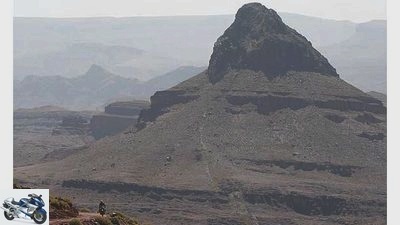
Kirchgebner / Osterle
Lonely and beautiful – magnificent slope in the rugged Djebel Sarhro.
getting there
There are several ways to get to Morocco: by axle, by car and trailer or by car train to Narbonne / southern France (www.db.autozug.de, from 220 euros one way). If you want to travel by bike, you should plan enough time for the 2500 kilometers to southern Spain (and back again). There are also ferry connections to Morocco from Genoa (Italy) and Sète (southern France). Otherwise: Almeria, Malaga, Algeciras and Tarifa (southern Spain). Information and prices at www.aferry.de, marokkotours.de, marrakech-info.com/marokko/faehren-europa-marokko.htm.
Travel time
Spring (March to May) and autumn (September to November) are ideal. Then there are pleasant climates throughout the country. In the mountains the snow has already melted and the desert is not yet too hot. In winter (December to February) the south is recommended for motorcyclists. The first snow falls in the High Atlas from December onwards, which can last into spring and make many passes impassable. The mountains can be bypassed along the Atlantic coast or in the far east of Morocco.
Documents
A passport that is still valid for at least six months and a green insurance card are required. Since some insurers do not include Morocco (MA), you must either take out temporary additional insurance at home (around 30 euros) or short-term liability insurance at the border. National driver’s license and vehicle license are sufficient. The currency is the dir-ham, and for one euro there is 11.60 of it. Almost all banks change travelers checks and cash, cash via credit and mostly also EC cards are available from banks in larger towns. As a direct payment method, credit cards are only accepted in large hotels and tourist centers.
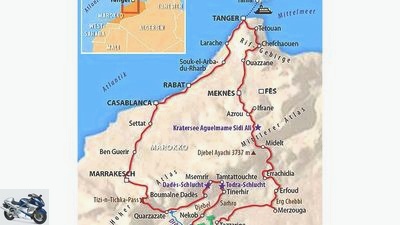
Map: Mairdumont / Maucher
Duration of the trip: 14 days; Distance covered: 3500 kilometers.
Stay
There are enough hotels of every price category in the tourist centers. Apart from that, rather simple conditions must be expected. We particularly liked the Auberge Baddou (www.auberge-baddou.com) in Tamtattouchte at the upper end of the Todra Gorge. The nice owner Moha Abaz cooks excellently and offers very clean rooms and shared showers. There are also numerous campsites, but the equipment and condition of the sanitary facilities vary greatly. For example, between Azrou and Ifrane at the junction to the large cedar there is a great place under cherry trees. Or at the local exit in Nekob towards Zagora, on the left, the very lovingly designed, green campground Ouadjou (www.ouadjou.com). Both have friendly operators and are highly recommended. Wild camping is basically possible, but you should look for a sheltered place to stay undisturbed.
gastronomy
Moroccan cuisine does not reveal its breadth of variation in all places. In return, you can get the national dish couscous (durum wheat semolina) with vegetables and meat as well as a tasty tagine (braised meat with vegetables) at affordable prices in almost every restaurant. The hygienic conditions do not (yet) meet European standards, especially with salads, fruit and open water, caution is advised.
Motorcycling
Morocco has the densest network of tar roads in North Africa. The main roads are all in good condition, but secondary routes are often poor. There is a dense network of filling stations as well as good quality unleaded petrol. Even when driving on the slopes, a range of 350 kilometers is sufficient. In terms of subsoil (from sandy to rocky) and degrees of difficulty, the countless slopes in the desert and in the Atlas Mountains offer the whole spectrum.
security
The Foreign Office (www.aus-waertiges-amt.de) advises to pay more attention in tourist areas and in the vicinity of religious places of worship because of the current risk of attacks. Due to drug traffickers, increased caution is also required in the Rif Mountains between Chefchaouen, Ketama and Fez. Drug possession is rigorously prosecuted and punished with heavy penalties.
literature
Erika and Astrid Darr wrote the standard work “Morocco – From the Rif to the Anti-Atlas” from the Reise Know-How series for 25 euros. The volume, updated in 2007, helps with planning and on site with many route descriptions and numerous GPS points. The Michelin sheet No. 742 “Morocco” in 1: 1000000 offers good orientation.
Related articles
-
MOTORCYCLE on the road in Morocco
Brings to travel MOTORCYCLE on the road in Morocco MOTORCYCLE on the road in Morocco North Africa’s last gap It has become tight in the northern Sahara….
-
to travel Morocco Morocco So close – so strange An enduro tour through the bitter Atlas Mountains takes you into the magical and strange world of the…
-
Morocco motorcycle tour for Africa beginners
Iron ham to travel Morocco motorcycle tour for Africa beginners Morocco motorcycle tour for Africa beginners Allah’s wild rock garden Mysterious cities,…
-
shepherd to travel Motorcycle tour in Morocco Motorcycle tour in Morocco Side effects welcome As one of the world’s most diverse countries, Morocco is an…
-
V-Power-Challenge: Through Morocco with Shell and Nick Sanders
Wood 33 pictures Dentges 1/33 “Turn left, uh, right I mean, after the second junction. Or was it the third?” Dentges 2/33 Berber Lahcen knows a lot about…
-
On the trail of the old Dakar Rally in Morocco
shepherd to travel On the trail of the old Dakar Rally in Morocco On the trail of the old Dakar Rally in Morocco Call of the desert Give everything…
-
Motorcycle tour through Algeria
to travel Motorcycle tour through Algeria Motorcycle tour through Algeria The dunes of the Sahara Algeria. The grave road, the sand dunes from Erg…
-
to travel South America ?? Antarctic South America ?? Antarctic 42 degrees of latitude On two enduros through the Andes ?? from the Chilean Atacama…
-
to travel Chile Chile High altitude rush In the north of the narrow country, Chile is in top form. Gravel passes climb up to 5000 meters over the…
-
to travel Iceland Iceland Caught cold If you enjoy encountering winter in summer, driving your enduro through rainy deserts or marveling at volcanoes and…